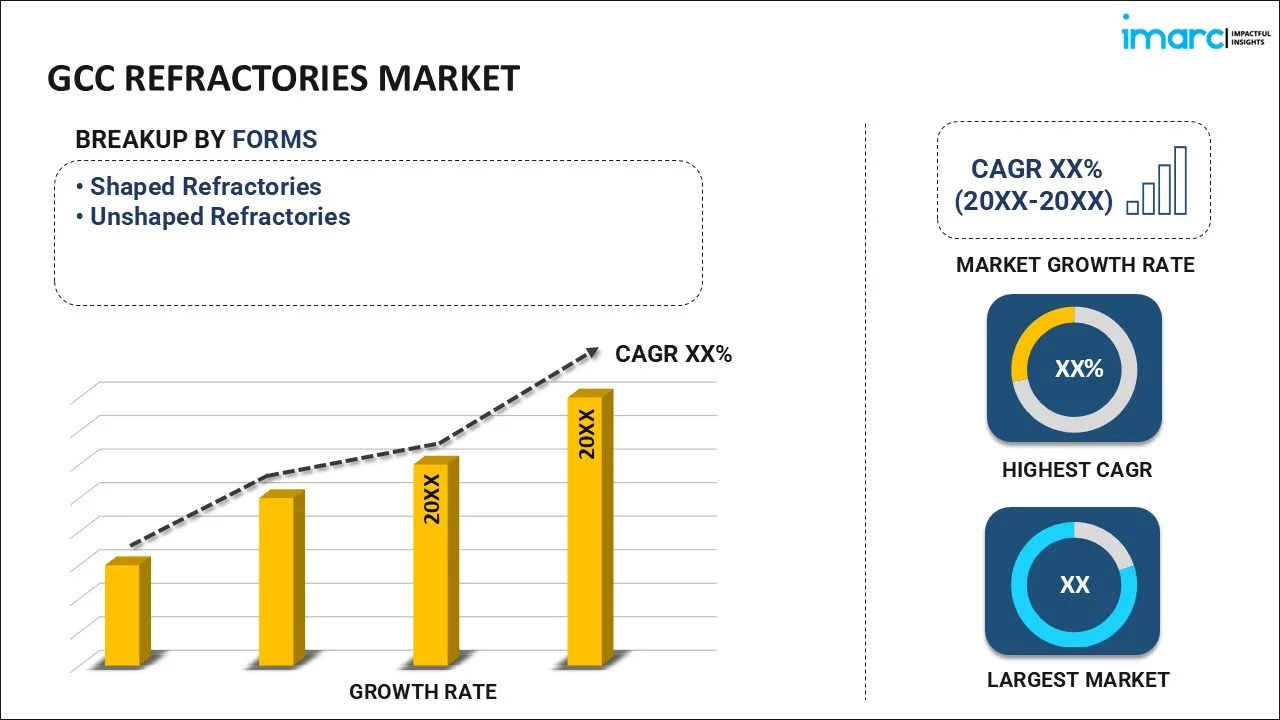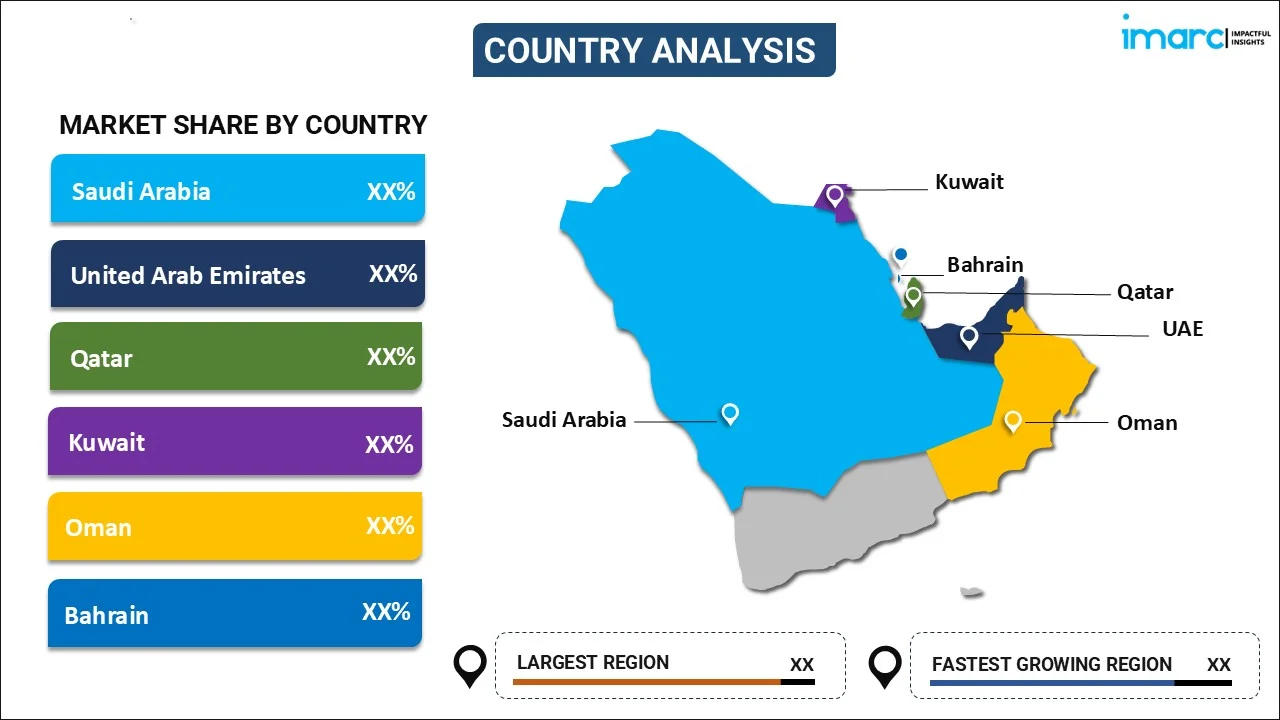
GCC Refractories Market Report by Form (Shaped Refractories, Unshaped Refractories), Alkalinity (Acidic and Neutral, Basic), Manufacturing Process (Dry Press Process, Fused Cast, Hand Molded, Formed, Unformed), Composition (Clay-Based, Nonclay-Based), Refractory Mineral (Graphite, Magnesite, Chromite, Silica, High Alumina, Zirconia, and Others), Application (Iron and Steel, Cement, Non-Ferrous Metals, Glass, and Others), and Country 2025-2033
Market Overview:
GCC Refractories market size reached USD 496.8 Million in 2024. Looking forward, IMARC Group expects the market to reach USD 751.1 Million by 2033, exhibiting a growth rate (CAGR) of 4.4% during 2025-2033. The expanding industries such as glass, petrochemicals, and non-ferrous metals, which require high-performance furnaces that rely on advanced refractory materials, is driving the market.
|
Report Attribute
|
Key Statistics
|
|---|---|
|
Base Year
|
2024 |
|
Forecast Years
|
2025-2033
|
|
Historical Years
|
2019-2024
|
| Market Size in 2024 | USD 496.8 Million |
| Market Forecast in 2033 | USD 751.1 Million |
| Market Growth Rate (2025-2033) | 4.4% |
Refactoring is the process of restructuring and improving the internal structure of existing code without altering its external behavior. It involves making code more efficient, readable, and maintainable by addressing issues like code smells, duplication, and complexity. Refactoring aims to enhance the overall quality of software, making it easier to understand, modify, and extend. Common refactoring includes extracting methods, renaming variables, and simplifying complex logic. Refactoring is an integral part of the software development lifecycle, allowing developers to continuously improve code as requirements evolve. By investing time in refactoring, teams can reduce technical debt, enhance collaboration, and create a more resilient and adaptable codebase.
GCC Refractories Market Trends:
The refractories market in GCC is poised for dynamic growth, driven by several key factors. Firstly, the burgeoning demand for refractories in the steel industry is a primary driver. As the steel sector experiences a robust expansion regionally, the need for high-performance refractory materials to withstand extreme temperatures in furnaces and converters becomes paramount. Furthermore, the escalating focus on infrastructure development and construction activities contributes significantly to the market's upward trajectory. Moreover, the push towards sustainable energy sources fuels the demand for refractories in the production of renewable energy, such as solar panels and wind turbines. The increasing adoption of advanced manufacturing technologies, including electric arc furnaces, is another pivotal factor propelling the refractories market. These technological advancements necessitate refractory materials with superior heat resistance and durability. Additionally, the automotive and aerospace industries' steady growth amplifies the need for refractories in the manufacturing of high-performance ceramics used in engine components and heat shields. In summary, a confluence of factors, including industrial expansion, infrastructure development, renewable energy initiatives, and technological advancements, collectively propels the refractories market in GCC towards a promising and dynamic future.
GCC Refractories Market Segmentation:
IMARC Group provides an analysis of the key trends in each segment of the market, along with forecasts at the regional and country levels for 2025-2033. Our report has categorized the market based on form, alkalinity, manufacturing process, composition, refractory mineral, and application.
Form Insights:

- Shaped Refractories
- Unshaped Refractories
The report has provided a detailed breakup and analysis of the market based on the form. This includes shaped refractories and unshaped refractories.
Alkalinity Insights:
- Acidic and Neutral
- Basic
A detailed breakup and analysis of the market based on the alkalinity have also been provided in the report. This includes acidic and neutral and basic.
Manufacturing Process Insights:
- Dry Press Process
- Fused Cast
- Hand Molded
- Formed
- Unformed
The report has provided a detailed breakup and analysis of the market based on the manufacturing process. This includes dry press process, fused cast, hand molded, formed, and unformed.
Composition Insights:
- Clay-Based
- Nonclay-Based
A detailed breakup and analysis of the market based on the composition have also been provided in the report. This includes clay-based and nonclay-based.
Refractory Mineral Insights:
- Graphite
- Magnesite
- Chromite
- Silica
- High Alumina
- Zirconia
- Others
The report has provided a detailed breakup and analysis of the market based on the refractory mineral. This includes graphite, magnesite, chromite, silica, high alumina, zirconia, and others.
Application Insights:
- Iron and Steel
- Cement
- Non-Ferrous Metals
- Glass
- Others
A detailed breakup and analysis of the market based on the application have also been provided in the report. This includes iron and steel, cement, non-ferrous metals, glass, and others.
Country Insights:

- Saudi Arabia
- United Arab Emirates
- Qatar
- Kuwait
- Oman
- Bahrain
The report has also provided a comprehensive analysis of all the major regional markets, which include Saudi Arabia, United Arab Emirates, Qatar, Kuwait, Oman, and Bahrain.
Competitive Landscape:
The market research report has also provided a comprehensive analysis of the competitive landscape in the market. Competitive analysis such as market structure, key player positioning, top winning strategies, competitive dashboard, and company evaluation quadrant has been covered in the report. Also, detailed profiles of all major companies have been provided.
GCC Refractories Market Report Coverage:
| Report Features | Details |
|---|---|
| Base Year of the Analysis | 2024 |
| Historical Period | 2019-2024 |
| Forecast Period | 2025-2033 |
| Units | Million USD |
| Scope of the Report | Exploration of Historical Trends and Market Outlook, Industry Catalysts and Challenges, Segment-Wise Historical and Future Market Assessment:
|
| Forms Covered | Shaped Refractories, Unshaped Refractories |
| Alkalinities Covered | Acidic and Neutral, Basic |
| Manufacturing Processes Covered | Dry Press Process, Fused Cast, Hand Molded, Formed, Unformed |
| Compositions Covered | Clay-Based, Nonclay-Based |
| Refractory Minerals Covered | Graphite, Magnesite, Chromite, Silica, High Alumina, Zirconia, Others |
| Applications Covered | Iron and Steel, Cement, Non-Ferrous Metals, Glass, Others |
| Countries Covered | Saudi Arabia, United Arab Emirates, Qatar, Kuwait, Oman, Bahrain |
| Customization Scope | 10% Free Customization |
| Post-Sale Analyst Support | 10-12 Weeks |
| Delivery Format | PDF and Excel through Email (We can also provide the editable version of the report in PPT/Word format on special request) |
Key Questions Answered in This Report:
- How has the GCC refractories market performed so far and how will it perform in the coming years?
- What has been the impact of COVID-19 on the GCC refractories market?
- What is the breakup of the GCC refractories market on the basis of form?
- What is the breakup of the GCC refractories market on the basis of alkalinity?
- What is the breakup of the GCC refractories market on the basis of manufacturing process?
- What is the breakup of the GCC refractories market on the basis of composition?
- What is the breakup of the GCC refractories market on the basis of refractory mineral?
- What is the breakup of the GCC refractories market on the basis of application?
- What are the various stages in the value chain of the GCC refractories market?
- What are the key driving factors and challenges in the GCC refractories?
- What is the structure of the GCC refractories market and who are the key players?
- What is the degree of competition in the GCC refractories market?
Key Benefits for Stakeholders:
- IMARC’s industry report offers a comprehensive quantitative analysis of various market segments, historical and current market trends, market forecasts, and dynamics of the GCC refractories market from 2019-2033.
- The research report provides the latest information on the market drivers, challenges, and opportunities in the GCC refractories market.
- Porter's five forces analysis assist stakeholders in assessing the impact of new entrants, competitive rivalry, supplier power, buyer power, and the threat of substitution. It helps stakeholders to analyze the level of competition within the GCC refractories industry and its attractiveness.
- Competitive landscape allows stakeholders to understand their competitive environment and provides an insight into the current positions of key players in the market.
Need more help?
- Speak to our experienced analysts for insights on the current market scenarios.
- Include additional segments and countries to customize the report as per your requirement.
- Gain an unparalleled competitive advantage in your domain by understanding how to utilize the report and positively impacting your operations and revenue.
- For further assistance, please connect with our analysts.
 Inquire Before Buying
Inquire Before Buying
 Speak to an Analyst
Speak to an Analyst
 Request Brochure
Request Brochure
 Request Customization
Request Customization




.webp)




.webp)












